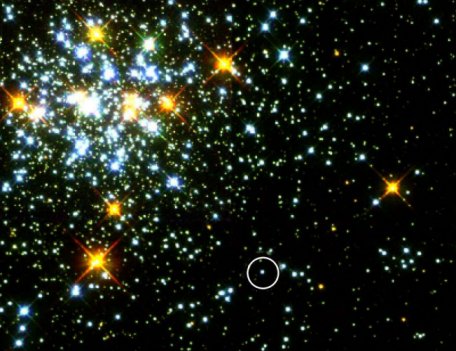Credit & Copyright: R. Elson and R. Sword
(IoA Cambridge),
NASA
Explanation:
This is NGC 1818,
a youthful, glittering cluster
of 20,000 stars residing in the
Large Magellanic Cloud,
164,000 light-years away.
Pick a star. Any star.
Astronomers might pick the unassuming bluish-white one (circled)
which appears to be a hot newly formed white dwarf star.
What makes it so interesting?
The
standard astronomical wisdom
suggests that stars over 5 times
as massive as the sun rapidly exhaust
their nuclear fuel and end their lives in a
spectacular supernova explosion.
With less than this critical mass they evolve into
red giants, pass through a relatively
peaceful planetary nebula phase,
and calmly fade away as
white dwarf stars like this one.
Except that as a member of the NGC 1818 cluster,
this new white dwarf would have evolved from
a red giant star
over 7.6 times as massive as the sun - which should have exploded!
Its discovery
will likely force astronomers to revise the
limiting mass estimate for supernovae upward.
1999 2000 2001 2002 2003 2004 2005 2006 2007 2008 2009 2010 2011 2012 2013 2014 2015 2016 2017 2018 2019 2020 2021 2022 2023 2024 2025 |
Январь Февраль Март Апрель Май Июнь Июль Август Сентябрь Октябрь Ноябрь Декабрь |
NASA Web Site Statements, Warnings, and Disclaimers
NASA Official: Jay Norris. Specific rights apply.
A service of: LHEA at NASA / GSFC
& Michigan Tech. U.
|
Публикации с ключевыми словами:
white dwarf - Эволюция звезд - Сверхновые - белый карлик - Планетарная туманность - Большое Магелланово Облако - звездное скопление
Публикации со словами: white dwarf - Эволюция звезд - Сверхновые - белый карлик - Планетарная туманность - Большое Магелланово Облако - звездное скопление | |
См. также:
Все публикации на ту же тему >> | |
